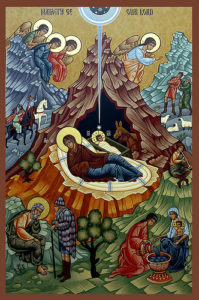The Twelve Weeks Of Christmas
 Most know the song, “The Twelve Days of Christmas.” On the first day of Christmas, my true love gave to me: a partridge in a pear tree. No, I’m not going to quote the whole song. It does remind us of one important fact. For most of Church history, Christmas wasn’t one day, but a twelve day period.
Most know the song, “The Twelve Days of Christmas.” On the first day of Christmas, my true love gave to me: a partridge in a pear tree. No, I’m not going to quote the whole song. It does remind us of one important fact. For most of Church history, Christmas wasn’t one day, but a twelve day period.
What we have today is an absence of Advent, replaced by what I call the twelve weeks of Christmas. Except instead of Christmas day kicking off the celebration, it ends it.
Christmas tends to be celebrated in the twelve weeks leading up to December 25th.
Admittedly, this is a bit of hyperbole. But not by much. The twelve weeks ending on Christmas day would start on October 3rd. Around this time people begin thinking about Halloween, which is seen as the beginning of the holiday season culminating in Christmas day.
We know by October 3rd, the retailers are already thinking about Christmas. Many will lament the commercialization of Christmas, but the buying always happens anyway. Retailers are going to supply demand.
It is not merely commercialism. We have Christmas parties in the weeks leading up to Christmas. We put on and attend special programs. We put up our tree and our lights weeks before Christmas day. We play and listen to Christmas music way before the day arrives.
Then once December 26th arrives, the lights go off, the tree goes down, the music ends, and so does Christmas. Some sort of extend the celebration to New Year’s Day, another seven days, but it is understood to be the holidays, not Christmas.
No, very few celebrate the fullness of Christmas. We celebrate Christmas during its preparation plus one day.
We’ve lost the concept of Christmas lasting twelve days.
The net effect is Christmas being more about food, family, and gifts, than it is about Christ. For many years we’ve heard the saying, “Jesus is the reason for the season” in an effort to combat the secularization of the celebration. But that requires actions, not mere words.
For the last several years, our family has made an effort to celebrate the full twelve days of Christmas. Our Christmas tree and lights remain up and on the whole time. After New Year’s Day, our house is usually the lone lit house on the block. I’m sure some of our neighbors have wondered about us when our lights are still blinking well into January.
The great thing about celebrating the full twelve days of Christmas is it gives you more opportunity to make Jesus the reason for the season. It is toward that end I offer the following book: Celebrating the Fullness of Christmas: Devotions on the 12 Days of Christmas. An inexpensive way to keep Christ in focus during your holiday celebrations.
May Jesus Christ, the Word of God come in the flesh to redeem us from our sins, be glorified in our commemoration of His birth over the next twelve days.







































Huh, I heard somewhere that the “Twelve Days of Christmas” song was coded Catholic symbols, invented during the English Catholic/Anglican flip-floppiness during a part where Catholics were the ones being cracked down on. /trivia of the day
But I can’t really blame people for getting tired of Christmas, since “Christmas” lasts nearly two full months, starting the second Halloween candy goes on 50% discount. If I hear “Let It Snow” or “Winter Wonderland” one more time, my eardrums might commit suicide.
I’ve never studied up on this “12 Days” thing, but I do know that in some cultures, the official Christmas is January 6. At one time that date was called Twelfth Night, the 12th day of Christmas. In the area of Ohio where I lived in for 29 years, January 6 was called Amish Christmas because that was the day the Amish celebrated it. The history of all this is a bit misty, but I think the important thing is that we who know Him celebrate Emmanuel, God with us, 365 days of the year.
True, Yvonne.
In the early church, everyone celebrated Christmas on Jan. 6 along with epiphany/theophany. At some point, the two were split and Christmas moved to Dec. 25., which incidentally is nine months after the commemoration of the annunciation to Mary the she would conceive a child.